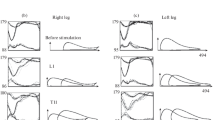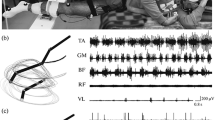Abstract
Electrical epidural stimulation of the dorsal surface of the spinal cord at the level of the second lumbar segment induced step-like movements accompanied by the corresponding electromyographic activity in the leg muscles in patients lacking supraspinal influences as a result of vertebral trauma. Triggering of stepping movements was shown to occur with particular stimulation parameters. The results provide evidence that in humans, as in other mammals, the spinal cord contains a network of interneurons acting as generators of stepping movements and producing coordinated patterns of movement activity. Experiments on chronic spinal cats demonstrated the leading role of the propriospinal system of the spinal cord in activating the spinal generators of stepping in response to epidural stimuli.
Similar content being viewed by others
REFERENCES
O. V. Kazennikov, M. L. Shik, and G. V. Yakovleva, “Stepping movements induced by stimulation of the dorsolateral column of the spinal cord in the cat,” Byull. Éksp. Biol. Med., 96, 8-10 (1983).
O. V. Kazennikov and M. L. Shik, “Distribution of activity along the 'stepping strip' of the spinal cord of the cat,” Neirofiziologiya, 20, 763-769 (1988).
G. N. Orlovskii, “Connections of reticulospinal neurons with the 'locomotor strip' of the brainstem,” Biofizika, 15, 171-177 (1970).
A. Makarovskii, A. Garbuz, Yu. Shapkov, and Yu. Gerasimenko, “An apparatus for the diagnosis and electrical stimulation of spinal cord structures,” Patent Application No. 1832515, 13 October 1992.
A. N. Makarovskii, A. E. Garbuz, and Yu. P. Gerasimenko, “An electrode 'fan' for implantation into the anterior surface of the dura mater of the spinal cord,” Patent No. 97119571, 3 December 1997.
M. L. Shik, F. V. Severin, and G. N. Orlovskii, “Control of gait and running by electrical stimulation of the midbrain,” Biofizika, 11, 659-666 (1966).
A. Bayoumi and A. Ashby, “Projections of group Ia afferents to motoneurons of thigh muscles in man,” Exptl. Brain. Res., 76, 223-228 (1989).
V. G. T. Beusekom, Fibre Analysis of the Anterior and Lateral Funiculi of the Cord in the Cat, Eduard Ijdo, Leiden (1956).
B. Coburn and W. K. Sin, “A theoretical study of epidural electrical stimulation of the spinal cord. Part I. Finite element analysis of stimulus fields,” IEEE Trans. Biomed. Eng., 32, 971-977 (1985).
M. Dmitrijevic, Yu. Gerasimenko, and M. Pinter, “Evidence for a spinal central pattern generator in humans,” Ann. N.Y. Acad. Sci., 860, 360-376 (1998).
S. Grillner and P. Zangger, “How detailed is the central pattern generation for locomotion?” Brain Res., 88, 367-371 (1975).
J. P. Hunter and P. Ashby, “Segmental effects of epidural spinal cord stimulation in humans,” J. Physiol. (London), 474, 407-419 (194).
E. Jankowska, I. Riddel, B. Skoog, and B. Noga, “Gating of transmission to motoneurones by stimulation applied in the locus coeruleus and raphe nuclei of the cat,” J. Physiol. (London), 461, 705-722 (1993).
D. P. C. Lloyd and A. K. McIntyre, “Dorsal column conduction of group in muscle afferent impulses and their relay through Clarke's column,” J. Neurophysiol., 13, No. 1, 39-54 (1950).
K. Matsuyama, F. Mori, and S. Mori, “Fine structure of a reticulospinal-interneuronal system for coordinating locomotor rhythm in cats,” in: From Basic Motor Control to Functional Recovery, N. Gantchev and G. Gantchev (eds.), Varna (1999), pp. 14-18.
B. Rexed, “Some aspects of cytoarchitectonics and synaptology of the spinal cord,” Progr. Brain Res., 2, 58-92 (1964).
H. E. Roaf and C. S. Sherrington, “Further remarks on the spinal mammalian preparation,” Quart. J. Physiol., 3, 209-211 (1910).
C. S. Sherrington, “Flexion-reflex of the limb, crossed extension-reflex, and reflex stepping and standing,” J. Physiol. (London), 40, 28-121 (1910).
M. L. Shik, “Recognizing propriospinal and reticulospinal systems of initiation of stepping,” Motor Control, 1, 310-313 (1997).
J. S. Steeves and L. M. Jordan, “Localization of a descending pathway in the spinal cord which is necessary for controlled treadmill locomotion,” Neurosci. Lett., 20, 283-288 (1980).
Author information
Authors and Affiliations
Rights and permissions
About this article
Cite this article
Gerasimenko, Y.P., Makarovskii, A.N. & Nikitin, O.A. Control of Locomotor Activity in Humans and Animals in the Absence of Supraspinal Influences. Neurosci Behav Physiol 32, 417–423 (2002). https://doi.org/10.1023/A:1015836428932
Issue Date:
DOI: https://doi.org/10.1023/A:1015836428932




